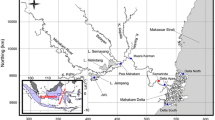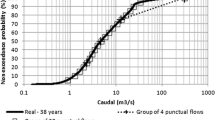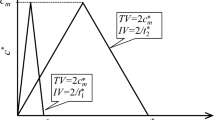Abstract
The adequate definition of the mixing zone generated by the discharge of an effluent is of great importance, as it serves as support for the environmental authorities on the decision-making about the authorization of the discharge. The evolution of the mixing zone of an effluent is affected by different kind of phenomena as temporal variations on the hydrodynamic conditions, spatial variations in the geomorphology and bathymetry of the receiving water, etc. The correct definition of the mixing zone should take into account these factors, for which the use of mathematical modelling is needed. The turbulent hydrodynamic processes in the near field of the discharge and in the far field occur at different spatial and temporal scales. The mathematical model needs to be able of simulating the hydrodynamic and transport processes on both fields. The present paper proposes a methodology to be followed when the prediction of the extents of the mixing zone generated by an effluent discharged into a river is needed. The methodology consists of the obtaining of the necessary hydrodynamic and pollutant concentration data on the effluent and on the receiving water; the building of the adequate calculation meshes for the modelling; the calibration and validation of the model; and finally the definition of the critical conditions for the prediction of the behaviour of the mixing zone. An example of application of the proposed methodology is shown for a real case, the discharge of the WWTP of Casar de Periedo town in the Saja River, Cantabria, Spain, for which field data have been measured. The prediction of the extents of the mixing zone for this case was made using a hydrodynamic two-dimensional depth-averaged long wave model jointly with a transport model. In order to simulate the near field and the far field jointly, an Embedded mesh system was built. For the Embedded mesh system, it was needed the establishment of conditions for the information exchange between the meshes.






















Similar content being viewed by others
References
Hall T, Fisher R, Rodgers J, Minshall G, Landis W, Kovacs T, Firth B, Dube M, Deardoff T, Borton D (2008) A long-term, multitrophic level study to assess pulp and paper mill effluent effects on aquatic communities in four US receiving waters: background and status. Integrated Environmental Assessment and Management 5(2):189–198
Kumar A, Tewary B, Banerjee M, Ahmad M (2010) A simplified approach for removal of suspended coal fines from black water discharge of mining and its allied industries. Journal of Mines Metals Fuels 58(11–12):346–348
David A, Tournoud M, Perrin J, Rosain D, Rodier C, Salles C, Bancon-Montigny C, Picot B (2012) Spatial and temporal trends in water quality in a Mediterranean temporary river impacted by sewage effluents. Environmental Monitoring Assessment 185(3):2517–2534
Salomons W (1995) Environmental impact of metals derived from mining activities: processes, predictions, prevention. Environmental Journal of Geochemical Exploration 25(1):5–23
Cailleaud K, Michalec F, Forget-Leray J, Budzinski H, Hwang J, Schmitt F, Souissi S (2011) Changes in the swimming behavior of Eurytemora affinis (Copepoda, Calanoida) in response to a sub-lethal exposure to nonylphenols. Aquat Toxicol 102(3–4):228–231
Lung W (1995) Mixing-zone modeling for toxic waste-load allocations. J Environ Eng 121(11):839–842
Alvarez C, Revilla JA, García A, Juanes JA, Medina R (2004) Design and operation of an industrial high-density waste water disposal system: The Usgo submarine outfall (Spain). 3rd International conference on marine waste water disposal and marine environment. 1st International Exhibition on Materials Equipment and Services for Coastal WWTP Outfalls and Sealines, Catania
Xu J, Lee J, Yin K, Liu H, Harrison P (2011) Environmental response to sewage treatment strategies: Hong Kong’s experience in long term water quality monitoring. Mar Pollut Bull 62(11):2275–2287
Biron P, Ramamurthy A, Han S (2004) Three-dimensional numerical modeling of mixing at river confluences. Journal of Hydraulic Engineering 130(3):243–253
Laraque A, Loup G, Filizola M (2009) Mixing processes in the Amazon River at the confluences of the Negro and Solimões Rivers, Encontro das Águas, Manaus, Brazil. Hydrol Process 23(22):3131–3140
Fetterolf C (1973) Mixing zone concepts. Biological methods for the assessment of water quality. American Society for Testing and Materials, Philadelphia, pp 31–45
Boxall J, Guymer I (2007) Longitudinal mixing in meandering channels: new experimental data set and verification of a predictive technique. Water Res 41(2):341–354
Martin J (1997) Ingeniería fluvial. Ed. Universidad Politécnica de Cataluña, Barcelona
Castanedo S (2000) Desarrollo de un modelo hidrodinámico tridimensional para el estudio de la propagación de ondas largas en estuarios y zonas someras. Tesis doctoral. Universidad de Cantabria
Einav R, Harussi K, Perry D (2002) The footprint of the desalination processes on the environment. Desalination 152(1–3):141–154
Honji H, Matsunaga N, Sugihara Y, Sakai K (1995) Experimental observation of internal symmetric solitary waves in a two-layer fluid. Fluid Dyn Res 15(2):89–102
Chernykh G, Zudin A (2005) Linear and nonlinear numerical models of local density perturbation dynamics in a stable stratified medium. Russian Journal of Numerical Analysis Mathematical Modelling 20(6):513–534
Jirka G (2008) Improved discharge configurations for brine effluents from desalination plants. Journal of Hydraulic Engineering 134(1):116–120
Lalli F, Bruschi A, Lama R, Liberti L, Mandrone S, Pesarino V (2010) Coanda effect in coastal flows. Coast Eng 57(3):278–289
Ki S, Hwang J, Kang J, Kim J (2009) An analytical model for non-conservative pollutants mixing in the surf zone. Water Science Technology 59(11):2117–2124
Sinton L, Hall C, Lynch P, Davies-Colley J (2001) Sunlight inactivation of fecal indicator bacteria and bacteriophages from waste stabilization pond effluent in fresh and saline waters. Appl Environ Microbiol 68(3):1122–1131
Schnurbusch S (2000) A mixing zone guidance document prepared for the Oregon Department of Environmental Quality. Master of Environmental Management Thesis, Portland State University
Jirka G, Bleninger T, Burrows R, Larsen T (2004) Environmental quality standards in the EC-Water Framework Directive: consequences for water pollution control for point sources. European Water Management Online. European Water Association (EWA). http://www.ewaonline.de/journal/2004_01h.pdf
Proni J, Huang H, Dammann W (1994) Initial dilution of southeast Florida ocean outfalls. Journal of Hydraulic Engineering 120(12):1409–1425
Huang H, Fergen R, Proni J, Tsai J (1998) Initial dilution equations for buoyancy-dominated jets in current. Journal of Hydraulic Engineering 124(1):105–108
Chin D (1985) Outfall dilution: the role of a far-field model. J Environ Eng 111(4):473–486
García A, Juanes JA, Álvarez C, Revilla JA, Medina R (2010) Assessment of the response of a shallow macrotidal estuary to changes in hydrological and wastewater inputs through numerical modeling. Ecol Model 221:1194–1208
Bárcena J, García A, García J, Álvarez C, Revilla J (2012) Surface analisys of free surface and velocity to changes in river flow and tidal amplitude on a shallow mesotidal estuary: an application in Suances Estuary (Nothern Spain). J Hydrol 420–421:301–318
Alvarez C, Juanes J, Revilla J, García A (2006) A two dimensional hydrodynamic model for the study of instream flows in rivers. 7th International conference on hydroinformatics, HIC 2006, Nice, France
Pérez E (2010) Methodological approach for the establishment of the mixing zone of the discharge of the wastewater treatment plant of Casar de Periedo in the Saja River. M.Sc. in environmental management of hydraulic systems. Universidad de Cantabria, Santader, p 67
Soriano T (2002) Modelado matemático de la evolución de contaminantes en sistemas fluviales. Tesis doctoral. Universidad de Cantabria
Koutitas C (1983) Elements of computational hydraulics. Pentech Press Limited, Londres
García A (2004) Desarrollo de un modelo tridimensional para la determinación del transporte de sustancias en estuarios y zonas someras. Tesis doctoral, Universidad de Cantabria
Sámano ML, Bárcena JF, García A, Gómez AG, Álvarez C, Revilla JA (2012) Flushing time as a descriptor for heavily modified water bodies classification and management: application to the Huelva Harbour. J Environ Manage 107:37–44
Graf WH, Altinakar MS (1998) Fluvial hydraulics. Flow and transport processes in channels of simple geometry. Wiley and Sons, Chichester
Chin D (2006) Water quality engineering in natural systems. Wiley-Interscience, Wiley and Sons Inc, Hoboken
Doneker R, Jirka G (1991) Expert systems for mixing-zone analysis and design of pollutant discharges. Journal of Water Resources Planning and Management 117(6):679–697
Doneker R, Jirka G (2002) Boundary schematization in regulatory mixing zone analysis. Journal of Water Resources Planning Management 128:46–56
Acknowledgments
Alonso J. Rodríguez Benítez is an Agencia Española de Cooperación Internacional MAEC-AECI Scholarship Beneficiary.
Author information
Authors and Affiliations
Corresponding author
Rights and permissions
About this article
Cite this article
Rodríguez Benítez, A.J., García Gómez, A. & Álvarez Díaz, C. Definition of mixing zones in rivers. Environ Fluid Mech 16, 209–244 (2016). https://doi.org/10.1007/s10652-015-9425-0
Received:
Accepted:
Published:
Issue Date:
DOI: https://doi.org/10.1007/s10652-015-9425-0




